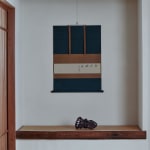Morita Shiryū (1912–1998)
Seishi biken
Ink on paper, hanging scroll
1941
With box authentication by Inada Sousai
Seal: Shiryu
14 x 68 cm
98 x 70 cm (overall)
1941
With box authentication by Inada Sousai
Seal: Shiryu
14 x 68 cm
98 x 70 cm (overall)
Further images
Exhibitions
2nd Keiseikai Exhibition. Tokyo: Kyukyodo, 1941.Literature
The Works of Shiryu Morita: Selected by the Artist. Kyoto: Bokubisha, 1971.
The present work, shown in 1941 at the Keisei Exhibition, is representative of a time when a fledgling bokusho (ink images) movement was in its infancy, about ten years before the founding of the Bokujinkai. At 14 x 68 cm, the relatively small work is wide compared to its height. The right half of the composition contains the four characters sei-shi-bi-ken and the artist’s signature and seal, while the left merely shows three minuscule ink dots. Morita himself described it in a 1956 issue of Bokujin in his article “Chronology of My Works” (“Watashi no sakureki”):
The dots meant to me something like placing spots of radium in the work […]. I thought
that just like radium incessantly emit x-rays and gamma rays, these dots will emit life’s
energy and reach people even in a thousand years from now.
Dots are like droplets on a surface of water that will cause a wave pattern when hitting
the water’s surface […]. That’s what I was thinking around the time when I made
Seishi biken. I wanted to evoke the notion of myself stirring up such wave patterns.
At that time, the response of Morita Shiryu’s calligraphy colleagues to his dots was mostly negative. Still, his attitude was that even as a calligrapher, he was also an artist and a human being, and these three dots, while “not being based on any written character, represented a budding desire to directly express my inner self.” For some time before Seishi biken, Morita had tried working with his eyes closed, without bothering about the result that remained on the paper. Now with these four characters and three dots, he walked the first steps on a path towards pure abstraction.
Morita Shiryu (avant-garde calligrapher; 1912–1998)
Avant-garde calligrapher from Hyogo Prefecture. Like fellow artist Inoue Yuichi, Morita studied under the calligraphy master Ueda Sokyu. He co-founded the avant-garde group Bokujinkai together with Inoue and was the founder and editor of the journal Bokubi (Beauty of Ink), both of which revolutionized traditional Japanese calligraphy and spread knowledge of Japanese avant-garde calligraphy to an international audience. He was posthumously awarded the Medal of Honor with Dark Blue Ribbon.
The dots meant to me something like placing spots of radium in the work […]. I thought
that just like radium incessantly emit x-rays and gamma rays, these dots will emit life’s
energy and reach people even in a thousand years from now.
Dots are like droplets on a surface of water that will cause a wave pattern when hitting
the water’s surface […]. That’s what I was thinking around the time when I made
Seishi biken. I wanted to evoke the notion of myself stirring up such wave patterns.
At that time, the response of Morita Shiryu’s calligraphy colleagues to his dots was mostly negative. Still, his attitude was that even as a calligrapher, he was also an artist and a human being, and these three dots, while “not being based on any written character, represented a budding desire to directly express my inner self.” For some time before Seishi biken, Morita had tried working with his eyes closed, without bothering about the result that remained on the paper. Now with these four characters and three dots, he walked the first steps on a path towards pure abstraction.
Morita Shiryu (avant-garde calligrapher; 1912–1998)
Avant-garde calligrapher from Hyogo Prefecture. Like fellow artist Inoue Yuichi, Morita studied under the calligraphy master Ueda Sokyu. He co-founded the avant-garde group Bokujinkai together with Inoue and was the founder and editor of the journal Bokubi (Beauty of Ink), both of which revolutionized traditional Japanese calligraphy and spread knowledge of Japanese avant-garde calligraphy to an international audience. He was posthumously awarded the Medal of Honor with Dark Blue Ribbon.









